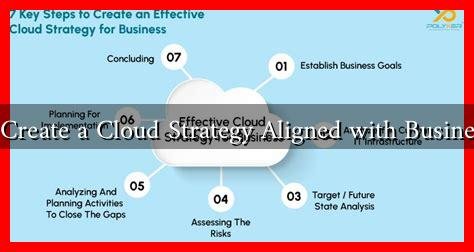-
Table of Contents
- How to Create a Cloud Strategy Aligned with Business Goals
- Understanding the Importance of a Cloud Strategy
- Steps to Create a Cloud Strategy Aligned with Business Goals
- 1. Define Business Objectives
- 2. Assess Current IT Infrastructure
- 3. Choose the Right Cloud Model
- 4. Develop a Migration Plan
- 5.
. Implement Governance and Security Measures
- Conclusion
How to Create a Cloud Strategy Aligned with Business Goals
In today’s digital landscape, businesses are increasingly turning to cloud computing to enhance their operations, improve efficiency, and drive innovation. However, simply migrating to the cloud is not enough; organizations must develop a comprehensive cloud strategy that aligns with their overarching business goals. This article will explore the essential steps to create a cloud strategy that not only meets technical requirements but also supports the organization’s mission and objectives.
Understanding the Importance of a Cloud Strategy
A well-defined cloud strategy is crucial for several reasons:
- Cost Efficiency: Cloud solutions can reduce IT costs by eliminating the need for extensive on-premises infrastructure.
- Scalability: Cloud services allow businesses to scale resources up or down based on demand, providing flexibility.
- Innovation: Cloud platforms often offer advanced technologies such as AI and machine learning, enabling businesses to innovate faster.
- Security and Compliance: A strategic approach ensures that security measures and compliance requirements are integrated into the cloud environment.
Steps to Create a Cloud Strategy Aligned with Business Goals
1. Define Business Objectives
The first step in developing a cloud strategy is to clearly define your business objectives. This involves understanding what your organization aims to achieve in the short and long term. Consider the following questions:
- What are the key performance indicators (KPIs) for your business?
- How can cloud technology help achieve these KPIs?
- What challenges are you currently facing that cloud solutions could address?
For example, a retail company may aim to enhance customer experience through personalized marketing, which can be supported by cloud-based data analytics tools.
2. Assess Current IT Infrastructure
Before migrating to the cloud, it is essential to evaluate your existing IT infrastructure. This assessment should include:
- Inventory of current applications and workloads
- Evaluation of performance and scalability needs
- Identification of any legacy systems that may hinder cloud adoption
By understanding your current setup, you can make informed decisions about which applications to migrate and which to leave on-premises.
3. Choose the Right Cloud Model
There are several cloud deployment models to consider, including:
- Public Cloud: Services offered over the public internet, ideal for scalability and cost-effectiveness.
- Private Cloud: Dedicated resources for a single organization, providing enhanced security and control.
- Hybrid Cloud: A combination of public and private clouds, allowing for flexibility and optimization of resources.
Choosing the right model depends on your business needs, regulatory requirements, and budget constraints. For instance, a financial institution may prefer a private cloud for sensitive data, while a startup might opt for a public cloud to minimize costs.
4. Develop a Migration Plan
Once you have defined your objectives and chosen a cloud model, the next step is to create a detailed migration plan. This plan should include:
- Timeline for migration
- Resource allocation and budget considerations
- Risk assessment and mitigation strategies
Case studies, such as that of Netflix, which successfully migrated its entire infrastructure to the cloud, can provide valuable insights into effective migration strategies.
5. Implement Governance and Security Measures
Security and compliance should be integral to your cloud strategy. Implement governance frameworks that include:
- Access controls and identity management
- Data encryption and backup solutions
- Regular audits and compliance checks
According to a report by McKinsey, organizations that prioritize security in their cloud strategy can reduce the risk of data breaches by up to 50%.
Conclusion
Creating a cloud strategy aligned with business goals is a multifaceted process that requires careful planning and execution. By defining clear objectives, assessing current infrastructure, choosing the right cloud model, developing a migration plan, and implementing robust governance measures, organizations can leverage the full potential of cloud computing. As businesses continue to navigate the complexities of digital transformation, a well-aligned cloud strategy will be a critical component of their success.
For further reading on cloud strategies, consider exploring resources from Gartner or AWS Cloud Strategy.





